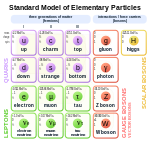| Flavour in particle physics |
|---|
| Flavour quantum numbers |
|
| Related quantum numbers |
|
| Combinations |
|
| Flavour mixing |
In particle physics, weak isospin is a quantum number relating to the electrically charged part of the weak interaction: Particles with half-integer weak isospin can interact with the
W±
bosons; particles with zero weak isospin do not.
Weak isospin is a construct parallel to the idea of isospin under the strong interaction. Weak isospin is usually given the symbol T or I, with the third component written as T3 or I3.T3 is more important than T; typically "weak isospin" is used as short form of the proper term "3rd component of weak isospin". It can be understood as the eigenvalue of a charge operator.
YouTube Encyclopedic
-
1/5Views:862 135809 6121 67210 7608 742
-
What If Charge is NOT Fundamental?
-
Electroweak Theory and the Origin of the Fundamental Forces
-
PHYS 485 Spin and Isospin
-
Baryons and Mesons and Quarks, Oh My! (Standard Model Part 4)
-
Unifying the Forces: Electroweak Theory (Standard Model Part 7)
Transcription
Notation
This article uses T and T3 for weak isospin and its projection. Regarding ambiguous notation, I is also used to represent the 'normal' (strong force) isospin, same for its third component I3 a.k.a. T3 or Tz . Aggravating the confusion, T is also used as the symbol for the Topness quantum number.
Conservation law
The weak isospin conservation law relates to the conservation of weak interactions conserve T3. It is also conserved by the electromagnetic and strong interactions. However, interaction with the Higgs field does not conserve T3, as directly seen by propagation of fermions, mixing chiralities by dint of their mass terms resulting from their Higgs couplings. Since the Higgs field vacuum expectation value is nonzero, particles interact with this field all the time even in vacuum. Interaction with the Higgs field changes particles' weak isospin (and weak hypercharge). Only a specific combination of electric charge is conserved. The electric charge, is related to weak isospin, and weak hypercharge, by
In 1961 Sheldon Glashow proposed this relation by analogy to the Gell-Mann–Nishijima formula for charge to isospin.[1][2]: 152
Relation with chirality
Fermions with negative chirality (also called "left-handed" fermions) have and can be grouped into doublets with that behave the same way under the weak interaction. By convention, electrically charged fermions are assigned with the same sign as their electric charge.
For example, up-type quarks (u, c, t) have and always transform into down-type quarks (d, s, b), which have and vice versa. On the other hand, a quark never decays weakly into a quark of the same Something similar happens with left-handed leptons, which exist as doublets containing a charged lepton (
e−
,
μ−
,
τ−
) with and a neutrino (
ν
e,
ν
μ,
ν
τ) with In all cases, the corresponding anti-fermion has reversed chirality ("right-handed" antifermion) and reversed sign
Fermions with positive chirality ("right-handed" fermions) and anti-fermions with negative chirality ("left-handed" anti-fermions) have and form singlets that do not undergo charged weak interactions.
Particles with do not interact with
W±
bosons; however, they do all interact with the
Z0
boson.
Neutrinos
Lacking any distinguishing electric charge, neutrinos and antineutrinos are assigned the opposite their corresponding charged lepton; hence, all left-handed neutrinos are paired with negatively charged left-handed leptons with so those neutrinos have Since right-handed antineutrinos are paired with positively charged right-handed anti-leptons with those antineutrinos are assigned The same result follows from particle-antiparticle charge & parity reversal, between left-handed neutrinos () and right-handed antineutrinos ().
| Generation 1 | Generation 2 | Generation 3 | |||||||||
|---|---|---|---|---|---|---|---|---|---|---|---|
| Fermion | Electric charge |
Symbol | Weak isospin |
Fermion | Electric charge |
Symbol | Weak isospin |
Fermion | Electric charge |
Symbol | Weak isospin |
| Electron | Muon | Tauon | |||||||||
| Up quark | Charm quark | Top quark | |||||||||
| Down quark | Strange quark | Bottom quark | |||||||||
| Electron neutrino | Muon neutrino | Tau neutrino | |||||||||
| All of the above left-handed (regular) particles have corresponding right-handed anti-particles with equal and opposite weak isospin. | |||||||||||
| All right-handed (regular) particles and left-handed anti-particles have weak isospin of 0. | |||||||||||
Weak isospin and the W bosons
The symmetry associated with weak isospin is SU(2) and requires gauge bosons with (
W+
,
W−
, and
W0
) to mediate transformations between fermions with half-integer weak isospin charges. [4] implies that
W
bosons have three different values of
-
W+
boson is emitted in transitions → -
W0
boson would be emitted in weak interactions where does not change, such as neutrino scattering. -
W−
boson is emitted in transitions → .
Under electroweak unification, the
W0
boson mixes with the weak hypercharge gauge boson
B0
; both have weak isospin = 0 . This results in the observed
Z0
boson and the photon of quantum electrodynamics; the resulting
Z0
and
γ0
likewise have zero weak isospin.
See also
Footnotes
References
- ^ Glashow, Sheldon L. (1961-02-01). "Partial-symmetries of weak interactions". Nuclear Physics. 22 (4): 579–588. doi:10.1016/0029-5582(61)90469-2. ISSN 0029-5582.
- ^ Greiner, Walter; Müller, Berndt; Greiner, Walter (1996). Gauge theory of weak interactions (2 ed.). Berlin Heidelberg New York Barcelona Budapest Hong Kong London Milan Paris Santa Clara Singapore Tokyo: Springer. ISBN 978-3-540-60227-9.
- ^
Baez, John C.; Huerta, John (2010). "The algebra of Grand Unified Theories". Bulletin of the American Mathematical Society. 47 (3): 483–552. arXiv:0904.1556. Bibcode:2009arXiv0904.1556B. doi:10.1090/s0273-0979-10-01294-2. S2CID 2941843.
- ^ An introduction to quantum field theory, by M.E. Peskin and D.V. Schroeder (HarperCollins, 1995) ISBN 0-201-50397-2; Gauge theory of elementary particle physics, by T.P. Cheng and L.F. Li (Oxford University Press, 1982) ISBN 0-19-851961-3; The quantum theory of fields (vol 2), by S. Weinberg (Cambridge University Press, 1996) ISBN 0-521-55002-5.















































